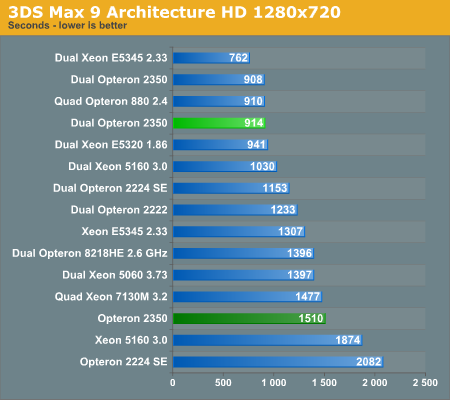AMD's Quad-Core Barcelona: Defending New Territory
by Johan De Gelas on September 10, 2007 12:15 AM EST- Posted in
- IT Computing
3ds Max 9 (32-bit Windows)
We tested with the 32-bit version of 3ds Max version 9, which has been improved to work better with multi-core systems but which is not as aggressively tuned for SSE as LINPACK and zVisuel. We used the "architecture" scene, which has been a favorite benchmarking scene for years. All tests were done with 3ds Max's default scanline renderer, SSE is enabled, and we rendered at HD 720p (1280x720) resolution. We measured the time it takes to render ten frames from 20 to 29. All results are reported in seconds, lower being better.

As this test has been our standard test for a while, we added results from previous tests. This time, Intel is firmly in the lead: most of the test runs well in the cache of each CPU. AMD did make a progress though. A Dual 3GHz Opteron 2222 is capable of generating about 29 frames per hour. As this benchmark scales well with clock speed, we may assume that a potential 3GHz Barcelona will be able to spit out ~35 frames per hour. In other words, the new quad-core is about 20% more efficient than the previous dual-core generation, core per core, clock per clock. This is also shown by the score of the quad Opteron 880 (2.4GHz). But it is not enough to beat the Intel armada: even a 2GHz Xeon will probably slightly beat the current 2GHz Opteron 2350.
We tested with the 32-bit version of 3ds Max version 9, which has been improved to work better with multi-core systems but which is not as aggressively tuned for SSE as LINPACK and zVisuel. We used the "architecture" scene, which has been a favorite benchmarking scene for years. All tests were done with 3ds Max's default scanline renderer, SSE is enabled, and we rendered at HD 720p (1280x720) resolution. We measured the time it takes to render ten frames from 20 to 29. All results are reported in seconds, lower being better.

As this test has been our standard test for a while, we added results from previous tests. This time, Intel is firmly in the lead: most of the test runs well in the cache of each CPU. AMD did make a progress though. A Dual 3GHz Opteron 2222 is capable of generating about 29 frames per hour. As this benchmark scales well with clock speed, we may assume that a potential 3GHz Barcelona will be able to spit out ~35 frames per hour. In other words, the new quad-core is about 20% more efficient than the previous dual-core generation, core per core, clock per clock. This is also shown by the score of the quad Opteron 880 (2.4GHz). But it is not enough to beat the Intel armada: even a 2GHz Xeon will probably slightly beat the current 2GHz Opteron 2350.










46 Comments
View All Comments
JohanAnandtech - Monday, September 10, 2007 - link
well said. I don't think AMD will have that advantage for a long time in 2P space :-)JackPack - Monday, September 10, 2007 - link
The problem is, 45nm Harpertown and 1600 MHz FSB will be rolling in soon.Barcelona would have looked great 6 or 9 months ago. But today, it's a little weak unless they can raise the frequency fast.
Viditor - Monday, September 10, 2007 - link
True, but so will HT 3.0 and the newer mem controller for the Barcelonas...
jones377 - Monday, September 10, 2007 - link
You got your work cut out for you now :)IntelUser2000 - Monday, September 10, 2007 - link
AMD won't compete against Intel's Tulsa chips anymore. They will have to compete against Tigerton Xeon MP and the newly introduced Clarksbro chipset.On the DP server platform, Intel will introduce Harpertown and Seaburg chipset. Seaburg chipset features 1600MHz bus with significantly improved memory controller performance. We'll see how it all turns out but as of now, Barcelona is a bit late to be competitive.
wegra - Monday, September 10, 2007 - link
You should not forget the Penryn. 2.5Ghz Barcelona will face to 3.1+Ghz Penryn. According to result from this article, I expect the performance of 2.5Ghz Barcelona will reach between 2.8 ~ 2.9Ghz Penryn. So wait till (hopefully) next year to see that AMD becomes the performance king. BTW, talking about the multi-processor servers, AMD will lead w/o much difficulties, I expect, thanks to the scalable architecture.